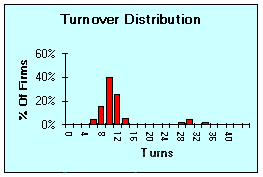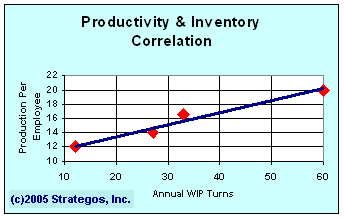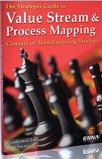The Mantra of Lean
Inventory is a recurring theme in Lean Manufacturing. Many authors and lecturers on Lean
Manufacturing say it is "evil". This white paper explores the role of inventory and why it is so
important to your manufacturing operation.
Inventory- Asset or Plague?
Inventory is probably one of the two biggest assets on your company's balance sheet. It is an
important determinant of Return On Assets (ROA) and other measures of financial performance.
Carrying stock is expensive, usually 20%-40% of the average value per year. It devours capital--
capital the business may need for growth. It requires large warehouses and valuable floor space.
It increases material handling. Large stocks require massive computer systems for tracking and
control.
Financial managers would never bank at an institution that offered a negative 25% interest
rate and inconvenienced the business in many ways. But they readily place their money in the
Bank of Inventory. This is because conventional accounting systems bury the true costs.
Yet, inventory can serve many purposes. It allows continuous delivery while manufacturing
focuses on long runs. It prevents the vagaries of maintenance and quality from interrupting
schedules. It accommodates the variation of incoming orders.
Is Inventory Really Evil?
Excessive inventory is not a problem nor is it evil; it is only an effect. Just as obesity
and fat are not problems; only symptoms of poor diet and insufficient exercise. The fundamental
causes of high inventory, like the fundamental causes of obesity lie deeper. Some of the more
common causes are shown below. Notice that the various remedies, taken together, constitute the
core disciplines of Lean Manufacturing.
How Much Inventory?
We usually measure inventory in "turns.": Annual sales divided by average value on hand. This
ratio allows comparison of larger and smaller firms. It accounts for changes in annual sales
volume and seasonal fluctuation. (While there are many variations of this metric, they matter
little as long as you are consistent.)
|

 The
table above shows average turns for several industries. Such comparisons are a valuable
benchmark. they help rate your firm's performance against others in the same or similar
industries. The
table above shows average turns for several industries. Such comparisons are a valuable
benchmark. they help rate your firm's performance against others in the same or similar
industries.
Averages are not all the story. In most industries, many firms cluster around the
average. A few firms are far above. Lean manufacturers show turns of 200%-1000% of their
industry average.
 Firms
with outstanding inventory performance excel on other dimensions such as customer service,
delivery and productivity. The accompanying chart shows the results from one of many studies
that support this contention. The study examined four similar firms in several countries. The
chart shows their WIP turns and productivity in units per employee. Firms
with outstanding inventory performance excel on other dimensions such as customer service,
delivery and productivity. The accompanying chart shows the results from one of many studies
that support this contention. The study examined four similar firms in several countries. The
chart shows their WIP turns and productivity in units per employee.
|






